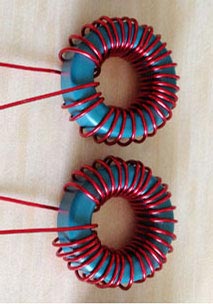An iron powder core can be built into shielding coil forms, e-cores, and toroids. The toroid coil is the most effective of out of the above listed configurations. A toroid is self-shielding, unlike a shielding coil, which allows the toroid to maintain flux within the core.  Flux will remain consistent throughout the full circumference of the core, and so there is no need to shield these inductors.
Flux will remain consistent throughout the full circumference of the core, and so there is no need to shield these inductors.
Powdered cores help toroids maintain their magnetic field. Powder cores come in two common types, and each offers its own characteristics. A carbon-iron core works well across a large spectrum of flux levels/temperatures. They have a high Q factor, which makes them great candidates for working within RF applications. They are frequently used when building high-powered broadband inductors.
A hydrogen-iron core is more permeable than a carbon-iron core, which gives hydrogen-iron a lower Q factor. These powdered cores are used almost exclusively in EMI environments. These cores can be found in switch mode power supplies because their lower permeability and strong stability.
Before ordering toroids, it is important to calculate saturation conditions. If you need help in this endeavor, reach out to us today! Well help ensure you get the right toroids with the right cores.
Related Reading Toroid Coil
- Is Winding a Toroid Necessary?
Toroids, and doughnut shaped inductors, are being used more frequently throughout electronic industries as a means to reduce leakage flux and to deal with EMI (electromagnetic interference).
- Toroids Confine Total B-Field
Toroid coils are great for dealing with B-fields, especially inside the inductor. Considering that the toroid has a closed circuit and symmetry from winding, a toroid is better suited than a straight inductor like a solenoid. - Benefits of Ferrite Cores
Make sure that you get the right toroid coil for the application you are trying to use.

